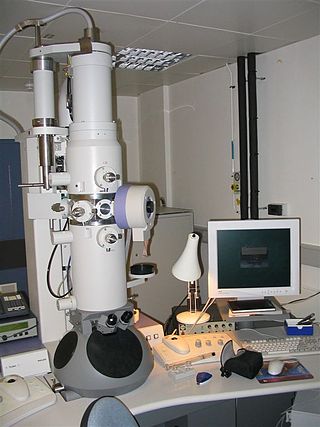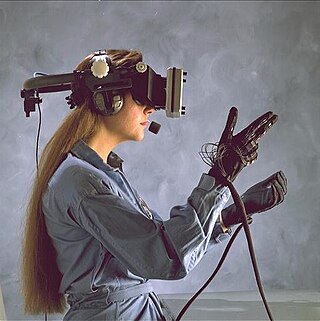Related Research Articles

An electron microscope is a microscope that uses a beam of electrons as a source of illumination. They use electron optics that are analogous to the glass lenses of an optical light microscope to control the electron beam, for instance focusing them to produce magnified images or electron diffraction patterns. As the wavelength of an electron can be up to 100,000 times smaller than that of visible light, electron microscopes have a much higher resolution of about 0.1 nm, which compares to about 200 nm for light microscopes. Electron microscope may refer to:

"There's Plenty of Room at the Bottom: An Invitation to Enter a New Field of Physics" was a lecture given by physicist Richard Feynman at the annual American Physical Society meeting at Caltech on December 29, 1959. Feynman considered the possibility of direct manipulation of individual atoms as a more robust form of synthetic chemistry than those used at the time. Although versions of the talk were reprinted in a few popular magazines, it went largely unnoticed until the 1980s.

Virtual reality (VR) is a simulated experience that employs 3D near-eye displays and pose tracking to give the user an immersive feel of a virtual world. Applications of virtual reality include entertainment, education and business. VR is one of the key technologies in the reality-virtuality continuum. As such, it is different from other digital visualization solutions, such as augmented virtuality and augmented reality.
Scanning probe microscopy (SPM) is a branch of microscopy that forms images of surfaces using a physical probe that scans the specimen. SPM was founded in 1981, with the invention of the scanning tunneling microscope, an instrument for imaging surfaces at the atomic level. The first successful scanning tunneling microscope experiment was done by Gerd Binnig and Heinrich Rohrer. The key to their success was using a feedback loop to regulate gap distance between the sample and the probe.

A head-mounted display (HMD) is a display device, worn on the head or as part of a helmet, that has a small display optic in front of one or each eye. HMDs have many uses including gaming, aviation, engineering, and medicine.

A wired glove is an input device for human–computer interaction worn like a glove.
Magnetic resonance force microscopy (MRFM) is an imaging technique that acquires magnetic resonance images (MRI) at nanometer scales, and possibly at atomic scales in the future. MRFM is potentially able to observe protein structures which cannot be seen using X-ray crystallography and protein nuclear magnetic resonance spectroscopy. Detection of the magnetic spin of a single electron has been demonstrated using this technique. The sensitivity of a current MRFM microscope is 10 billion times greater than a medical MRI used in hospitals.
Vuzix is an American multinational technology company headquartered in Rochester, New York and founded by Paul Travers in 1997. Vuzix is a supplier of wearable virtual reality and augmented reality display technology. Vuzix manufactures and sells computer display devices and software. Vuzix head-mounted displays are marketed towards mobile and immersive augmented reality applications, such as 3D gaming, manufacturing training, and military tactical equipment. On January 5, 2015, Intel acquired 30% of Vuzix's stock for $24.8 million.

In 3D computer graphics, 3D modeling is the process of developing a mathematical coordinate-based representation of a surface of an object in three dimensions via specialized software by manipulating edges, vertices, and polygons in a simulated 3D space.

Leap Motion, Inc. was an American company that manufactured and marketed a computer hardware sensor device that supports hand and finger motions as input, analogous to a mouse, but requires no hand contact or touching. In 2016, the company released new software designed for hand tracking in virtual reality. The company was sold to the British company Ultrahaptics in 2019, which rebranded the two companies under the new name Ultraleap.

Oculus Rift is a discontinued line of virtual reality headsets developed and manufactured by Oculus VR, a virtual reality company founded by Palmer Luckey that is widely credited with reviving the virtual reality industry. It was the first virtual reality headset to provide a realistic experience at an accessible price, utilizing novel technology to increase quality and reduce cost by orders of magnitude compared to earlier systems. The first headset in the line was the Oculus Rift DK1, released on March 28, 2013. The last was the Oculus Rift S, discontinued in April 2021.
Virtual home design software is a type of computer-aided design software intended to help architects, designers, and homeowners preview their design implementations on-the-fly. These products differ from traditional homeowner design software and other online design tools in that they use HTML5 to ensure that changes to the design occur rapidly. This category of software as a service puts an emphasis on usability, speed, and customization.

Tamiko Thiel is an American artist, known for her digital art. Her work often explores "the interplay of place, space, the body and cultural identity," and uses augmented reality (AR) as her platform. Thiel is based in Munich, Germany.

Reality Labs, formerly Oculus VR, is a business and research unit of Meta Platforms that produces virtual reality (VR) and augmented reality (AR) hardware and software, including virtual reality headsets such as Quest, and online platforms such as Horizon Worlds. In June 2022, several artificial intelligence (AI) initiatives that were previously a part of Meta AI were transitioned to Reality Labs. This also includes Meta's fundamental AI Research laboratory FAIR which is now part of the Reality Labs - Research (RLR) division.
Matthew Putman is an American scientist, educator, musician and film & stage producer. He is best known for his work in nanotechnology, the science of working in dimensions smaller than 100 nanometers. Putman currently serves as the CEO of Nanotronics Imaging, an advanced machines and intelligence company that has redefined factory control through the invention of a platform that combines AI, automation, and sophisticated imaging to assist human ingenuity in detecting flaws in manufacturing. He recently built New York State’s first high-tech manufacturing hub, located in Building 20 of the Brooklyn Navy Yard.

Google Cardboard is a discontinued virtual reality (VR) platform developed by Google. Named for its fold-out cardboard viewer into which a smartphone is inserted, the platform was intended as a low-cost system to encourage interest and development in VR applications. Users can either build their own viewer from simple, low-cost components using specifications published by Google, or purchase a pre-manufactured one. To use the platform, users run Cardboard-compatible mobile apps on their phone, place it into the back of the viewer, and view content through the lenses.

Windows Mixed Reality (WMR) is a discontinued platform by Microsoft which provides augmented reality and virtual reality experiences with compatible head-mounted displays.

The Aphelion Imaging Software Suite is a software suite that includes three base products - Aphelion Lab, Aphelion Dev, and Aphelion SDK for addressing image processing and image analysis applications. The suite also includes a set of extension programs to implement specific vertical applications that benefit from imaging techniques.

A virtual reality headset is a head-mounted device that uses 3D near-eye displays and positional tracking to provide a virtual reality environment for the user. VR headsets are widely used with VR video games, but they are also used in other applications, including simulators and trainers. VR headsets typically include a stereoscopic display, stereo sound, and sensors like accelerometers and gyroscopes for tracking the pose of the user's head to match the orientation of the virtual camera with the user's eye positions in the real world.
Tilt Brush is a room-scale 3D-painting virtual-reality application available from Google, originally developed by Skillman & Hackett.
References
- 1 2 Finley, Klint (April 24, 2015). "New VR Tech Lets You Explore Worlds at the Nanoscale". Wired Magazine . Retrieved 5 April 2016.
- 1 2 3 4 Mackinnon, Jim (February 2, 2015). "Nanotronics Imaging in Cuyahoga Falls seeks to revolutionize industries by making a big deal out of the smallest things". Akron Beacon Journal . Retrieved 5 April 2016.
- 1 2 McKenzie, Hamish (November 2, 2012). "Matthew Putman's super resolution and the poetry of nanotechnology". PandoDaily . Retrieved 5 April 2016.
- ↑ "Peter Thiel's Newest Obsession: Nanotechnology". Reuters. February 20, 2014. Archived from the original on March 10, 2014. Retrieved 5 April 2016.
{{cite news}}: CS1 maint: unfit URL (link) - ↑ "Nanotronics Imaging Acquires Franklin MCI To Become Full-System Provider of Custom Nanoimaging Solutions". BusinessWire. May 19, 2015. Retrieved 5 April 2016.
- ↑ Gaglani, Shiv (March 24, 2014). "Seeing the Invisible: Interview with Nanotronics CEO". Medgadget . Retrieved 5 April 2016.
- ↑ Murphy, Mike (April 24, 2015). "A new microscope uses virtual reality to let you walk through atomic-level vistas". Quartz . Retrieved 5 April 2016.